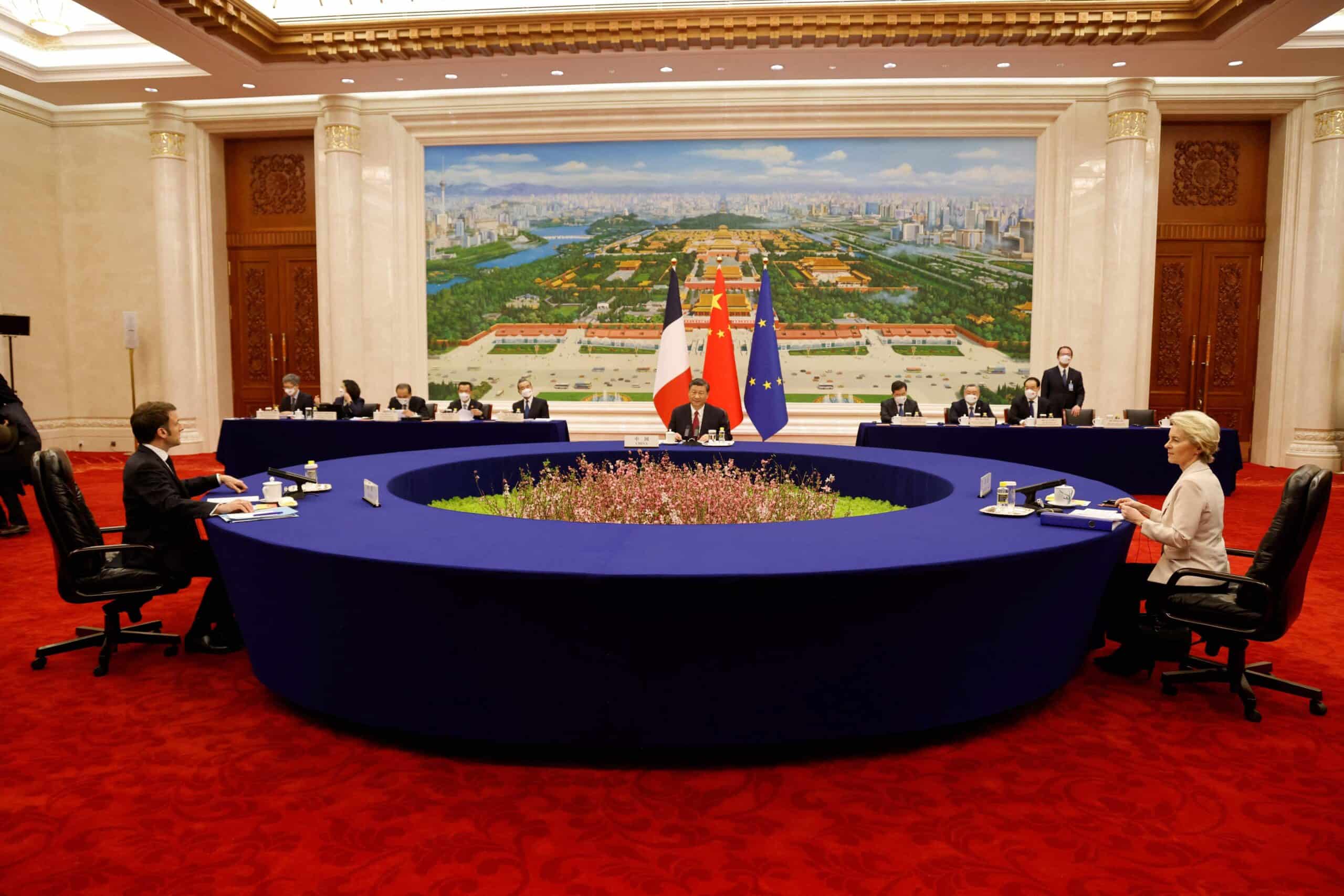Interview conducted by Jan Normann and Andrea Bogoni.
In December 2023 Blue Europe published “The Dragon at the Gates of Europe: Chinese presence in the Balkans and Central-Eastern Europe” edited by Andrea Bogoni and Brian Fabrègue. The book analyses both broad international aspects and country-specific implications of Beijing’s role in the region. We have invited Dr. Ewa Cieślik [1], a distinguished economist and professor at the Poznań University of Economics and Business, to give us her insights on the topic of EU-China economic relations, especially considering the ongoing war in Ukraine. Her expertise on the Belt and Road Initiative (BRI) and the economic impacts of Chinese policies on the European market makes this interview especially relevant in understanding the increasingly dynamic interactions shaping today’s global economy.
1. What is the current state of economic relations between the EU and China?
The EU’s relations with China in recent years have been a mixture of economic interests with the dominance of political issues, particularly on the part of the EU. This jigsaw is completed by the US, which has been pursuing a policy of decoupling from China for several years. It is mainly due to the US-China conflict that the EU has begun to consider greater autonomy from the world’s major economies.
However, the key EU economies do not at all see independence as a separation from China or the US. Rather, they are keen to create a balanced relationship with these countries while protecting their own interests. One only needs to look at Germany’s and France’s relations with the ‘Middle Kingdom’, for example. Although the two European economies disagree on many issues concerning China’s role in the EU (e.g. investigations into the carriage of Chinese electric vehicles), they try, mainly for economic reasons, to deal with Beijing individually. They also emphasise (strongly emphasised during Xi Jinping’s visit to Europe) that the EU conducts independent diplomacy, which was seen by some as an affront to the US.
This attitude of the major EU economies is hardly surprising as, despite political frictions, China remains a key economic partner for them. For Beijing too, improved economic relations with the EU are a significant element in their development strategy. Although China’s economy is undergoing a transformation to one based more on domestic consumption, trade, manufacturing and capital ties will continue to play an important role.
In 2023, China was the EU’s largest import partner for goods (20.5% of total imports from outside the Community) and its third largest export partner for goods (8.8% of total exports from outside the EU). Investment-wise, the economies are no longer as strongly linked, but they certainly cannot ignore each other.
China has been losing a bit of its appeal recently as the business environment there has deteriorated. This is not only due to stricter regulations, but also to the economic slowdown. This year’s survey by the European Union Chamber of Commerce in China shows that 68% of European companies rated the business environment in China worse than in 2023, and only 42% of them are considering expanding their operations there, which was the lowest level in a decade. In contrast, 25% of respondents have shifted existing or plan to shift future investments from China to other countries.
Appreciating the importance of the EU, especially in the face of conflict with the US, Beijing is trying to counteract the deterioration of relations with the Community using various methods. For example, during a recent visit, Xi Jinping exploited divisions in Europe over the US and Ukraine issues and tempted European companies with better market access. During the ongoing Euro 2024, 5 of the 14 main partners of the championship are Chinese companies.
The EU is trying to develop an individual strategy towards China. However, the lack of unanimity makes action incoherent and ineffective. On the one hand, disagreements within the EU increase uncertainty for companies, but on the other hand, they provide an opportunity for Beijing to hold bilateral talks with friendlier economies. The EU’s repetition of slogans such as derisking or systemic competitor in relation to China does not bear the hallmarks of a well thought-out strategy. It also lacks an idea of how to work with Beijing to solve global problems. And the piecemeal handling of economic and technological issues with the sole aim of defending its own market (examples of electric cars or solar panels) is far from a coherent vision. The situation is further complicated by the war in Ukraine and Sino-Russian relations.
In conclusion, polarisation in the EU’s vision of relations with China is deepening. And the outcome of the June elections is unlikely to bring a consensus closer. Irrespective of its sympathies for China, the EU must realise that the Asian giant has long been a global superpower and that a thoughtful, long-term and multidimensional strategy for dealing with it must be developed. It is therefore worthwhile for the Community to model itself in some aspects on China’s pragmatic approach to foreign and economic policy. It should also be borne in mind that Beijing is keen to have good relations with the Community, and it is worth exploiting this in mutual dialogue and inviting China as often as possible to participate in debates on global issues. The EU and China will have different views on many issues (as do the EU and the US), but it is important that differences do not deter cooperation and communication.
2. Has Russia’s aggression on Ukraine changed China’s approach towards EU countries?
The war in Ukraine has complicated the already difficult EU-China relationship. Moreover, Beijing is exploiting differences in views on the conflict in building its position not only in the EU, but also in the world. China’s stance on the situation in Ukraine has been consistent – sticking to the principle of non-interference in the internal affairs of other countries in order to maintain stability and sovereignty. This attitude, although often criticised in the EU, is often appreciated by developing countries.
Officially maintaining its neutrality, China has not curtailed its relations with Russia, but is showing greater caution in them. It is possible that they would be less restrained in their dealings with Moscow were it not for their entanglement with the US and frigid relations with the EU. China’s economy is still heavily oriented towards commodity exports and raw material imports, and companies are connected to global value chains, so it is in Beijing’s interest to maintain both correct relations with Russia and the West.
The situation became a little more complicated after a joint statement issued by China and Russia in May (just after Xi Jinping returned from a tour of Europe) saying that they saw the strategic infrastructure of Western ‘military alliances’ as a threat. Many commentators have argued that this is a step towards a military alliance and a new Cold War. However, such a scenario is unlikely, as it is not in Beijing’s interest to isolate itself from the West. Also, it can still be expected to, acceptably, cooperate within the EU to resolve the conflict in Ukraine. In addition, some understanding is taking shape in the EU between China and France and Germany about seeking a political solution to the war.
The EU views China’s role in the Ukraine conflict in two ways. On the one hand, it is aware that China has the greatest influence over Moscow. This was demonstrated by the EC President, who acknowledged at a trilateral meeting in France that Beijing had played an important role in de-escalating Russia’s nuclear threats. Although there is no shortage of opinions that China is using Russia to play the West and destabilise it. On the other hand, the EU is concerned about Beijing’s close ties with Moscow. China has made no secret of the fact that it sides with Moscow in the UN Security Council and favours it in proposals for a truce in Ukraine. However, the biggest blow to the EU is the fact that China has not only not severed economic ties with Russia, but has further developed this cooperation. It continues to import energy resources (Russian agencies estimated that half of the country’s oil and gas exports went to the Chinese market) and export machinery and technology, which weakens the effect of the sanctions imposed on Russia while making it heavily dependent on the Chinese market. After all, in 2023, the exchange between the two countries reached a record (over USD 240 billion). Recently, the Russian central bank announced that the renminbi had become the most important settlement currency in the face of limited access to the dollar and euro. The tightening of Sino-Russian relations is also the result of the US and Europe distancing themselves from China. Wanting to ensure its national security and revitalise its economy, China has naturally turned to Russia.
It is still an open question whether Beijing will ultimately decide to disengage from Russia and although some speculate that this will happen, it must come at the cost of improving relations with the EU (or the West more broadly). However, looking at the constancy of the Chinese authorities’ views and calculations, this is rather unlikely. China’s relationship with Russia has a long complicated history. In Beijing’s understanding, isolating Russia could prove dangerous for the world and rather technically unfeasible. The consequences of doing so can already be seen in the examples of much smaller economies. At the same time, Europe is too important for China to bet everything on one card and openly support Russia. Therefore, barring some unforeseen event, the scenario is unlikely to change: China will remain committed to keeping economic relations with the EU as stable as possible while maintaining strong ties with Russia, making some concessions to each of these economies from time to time. At the same time, taking advantage of the weakening of Russia, Beijing will expand its sphere of influence in Eurasia.
3. The Belt and Road Initiative is an important aspect of China’s foreign policy. How has the EU responded to the BRI and what impact has it had on EU-China relations?
The cooling of EU-China relations also translates into China’s global project, the BRI. In general, Europe has split into two camps in its perception of the initiative. Generally speaking, in Western Europe, which is more sceptical of the initiative, it is beginning to change its shape and is moving away from typical infrastructure projects or industrial investment and more towards financial connectivity. In Central and Eastern Europe (CEE), on the other hand, classic BRI investments continue to dominate, although a change in the countries’ attitudes towards Chinese ventures is also evident.
Such a two-track approach to the BRI in Europe existed almost from the outset. Western European countries (Italy was the exception until recently) were already expressing their disappointment less than 3 years after the announcement of the BRI about the lack of balancing trade with China, the unequal treatment of European companies in the market there and the requirement for them to share know-how. Over time, Chinese investment began to be blocked and the activity of Western European companies in China restricted. Additionally, at the end of 2023, the only G7 country that is a member of the BRI – Italy – officially left the initiative.
Greater enthusiasm towards the BRI was seen in CEE. Even before the official launch of the strategy, Beijing announced the ‘16+1’ format (today reduced to ‘14+1’), which offered hopes of investment and closer relations on a win-win basis in other areas of cooperation. Unfortunately, the format failed to fulfil its role as a ‘booster’ for the BRI. Many factors contributed to this, including political ones. Only a few countries from the region remained friendly to the BRI, the most important of which are Bulgaria, Romania, Hungary and the Balkan countries. This is where the initiative’s investments have shifted in recent times.
Despite growing scepticism, CEE economies accounted for more than 70% of Chinese BRI investment in Europe by the third quarter of 2023 (according to the American Enterprise Institute). If all Chinese investment in Europe is taken into account, CEE attracted mostly BRI investment (more than 80% of all Chinese investment in the region). Nevertheless, almost 90% of all Chinese investment went to Western Europe (mainly France, Germany and the UK), of which BRI investment accounted for only 4%. However, 2023 was a peculiar year – the share of the region’s major economies (Germany, France and the UK) in total Chinese investment to Europe fell from 63.6% to 35.3% while CEE attracted more than half of Chinese investment (of which Hungary accounted for more than 44%). Moreover, BRI investment outweighed the rest and, apart from Austria, went exclusively to CEE.
In the European media, BRI projects are often linked to accusations of corruption, deliberate indebtedness of beneficiaries and dependence on Beijing. It is not often overlooked that, thanks to the BRI, Eurasian connections have been strengthened. It has been estimated that trains linking China to the rest of Asia have so far travelled 90,000 times, and the network now serves 223 cities in 25 European countries and more than 100 cities in 11 Asian countries. Indeed, around one-third of BRI investments are at some risk, but precarious investments in Europe represent a negligible percentage.
Western Europe, on the other hand, sceptical of the BRI, realises that the next phase of the initiative will involve the promotion of the Chinese currency and that traditional projects will recede into the background (although there are some countries interested in it, such as Spain). Practically, the next fase will encompass increasingly linking the international financial market with China. The UK (the second largest offshore economy for the renminbi in the world behind Hong Kong), France and Germany are leading the way in this sphere. The Chinese currency has an increasingly strong presence in European-Chinese settlements and the role of the euro and renminbi in held reserves is also growing. Centres trading Chinese securities have also emerged. The renminbi now ranks 5th in the world in terms of international payments excluding eurozone payments and 4th in global payments.
In conclusion, the BRI fiasco has already been announced several times in the media, but there is no indication of this. Indeed, the pandemic and Beijing’s decision to freeze activity have slowed down the initiative. In addition, some governments were concerned about their debt to China. There were also rumours that Beijing did not have enough funds to implement projects. However, as the economy recovers, BRI activity is returning. Just browse the official website of the initiative and there one finds a rash of different BRI activities. This is why Brussels has decided to launch a competing project, the Global Gateway.
4. Are there any specific EU projects or policies that are seen as a counterweight to the BRI?
The most obvious competing EU project for China’s BRI is the aforementioned ‘Global Gateway’ introduced at the end of 2021. This is the EU’s first global plan, under which the Community intends to invest €300 billion by 2027 (Africa is expected to absorb half of these funds). The official aim of the EU strategy is to strengthen partnerships with non-EU countries through infrastructure projects. However, the project itself is rather enigmatic, leading one to assume that there is much more geopolitics involved than an actual desire to improve the infrastructure of developing countries. These characteristics of the ‘Global Gateway’ are consistent with those of the BRI. In contrast, what distinguishes the EU plan from the Chinese project are the requirements that must be respected for investment, namely standards of democracy, rule of law, transparency and sustainability. Investments prioritise clean technologies and renewable energy sources. A considerable advantage of the ‘Global Gateway’ over the BRI is its stringent assumptions, which will minimise debt risk. The EU seems to have experience in this area (e.g. EIB). Interest rates on loans can be low and the scrutiny of projects can be very meticulous. This will make the initiative more viable and minimise project fiascos.
“Global Gateway”, like BRI, is a tool to promote the economic and development model in the countries where the projects will be carried out. This means that some beneficiaries will not show interest in EU investment if it involves too much interference in their internal affairs and too complicated procedures. Against this backdrop, the Chinese offer may seem more attractive – getting more money faster without intricate formalities. There is another sensitive element where the EU loses out to China among the main beneficiaries: African countries. The economies there are characterised by distrust of Europe. Historical issues aside, until recently China was the only option for loans and investment for many African countries, as the West was not particularly interested in major ventures in these areas. In this way, Beijing has built up a strong influence on the continent and is pursuing its geopolitical interests, which will be difficult for the EU to undermine. The “Global Gateway”, however, may convince countries more critical of China, as exemplified by Vietnam or Nepal.
At present, it is difficult to talk about the effectiveness of Global Gateway. At last year’s Global Gateway Forum in Brussels (25-26 October), no evidence was presented that the project has had any significant impact on EU partners. The IMEC (India-Middle East-Europe Economic Corridor) can be considered a certain success, but given the current geopolitical situation in these regions, there is a considerable possibility that it might fail. By comparison, the BRI has so far created 420,000 jobs globally, reduced transport costs and the projects it has delivered are estimated to be worth over US$1 trillion. The initiative is often criticised for failing to take environmental issues into account. However, this is changing drastically, with more than 40% of energy projects announced in the first half of last year being wind power. The BRI is also making a strong contribution to the world’s energy transition.
There is another legitimate doubt about the future of the ‘Global Gateway’. If the EU’s main motive in launching the strategy is to weaken China’s influence, then the motivation should probably be rethought. It is the development of backward regions and the improvement of the living standards of the people there that should be the reason for launching the project: it is just that such ambitious goals are not achieved alone, but in cooperation (also with Beijing). On the other hand, confronting potential beneficiaries with the choice of either us or the Chinese does not create a positive image of the EU among developing countries.
Endnotes
-
Dr. Ewa Cieślik is an economist and professor at the Poznań University of Economics and Business in Poland (ResearchGate, ORCID). With a profound expertise in international economics, particularly focusing on China and its relations with the European Union, Dr. Cieślik has made significant contributions to the field through her research. She holds a PhD in Economics and has an extensive publication record that includes numerous articles and papers on topics such as global economic trends, the Belt and Road Initiative, and the economic impact of Chinese policies on the European market. Dr. Cieślik is also actively involved in various international research projects and member of several economic and academic organizations. ↑





